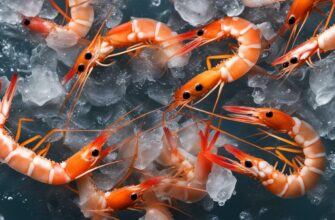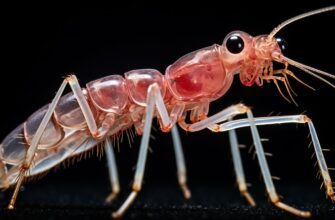Welcome to our informative article where we delve into the fascinating world of shrimp and their ability to survive outside of water. There has long been a common belief that shrimp cannot live for extended periods away from their aquatic habitat. However, prepare to be surprised as we uncover the truth behind their remarkable adaptability.
- The Lifespan of Shrimp in Water
- The Oxygen Requirement of Shrimp
- Adaptations for Survival on Land
- Adaptations for Survival on Land
- How Long Can Shrimp Survive Out of Water?
- Factors Affecting Shrimp’s Survival Out of Water
- Factors Affecting Shrimp’s Survival Out of Water:
- The Importance of Moisture for Shrimp
- Human Interactions and Shrimp Out of Water
- Frequently Asked Questions about Shrimp Survival Out of Water
- Q: Can all shrimp survive out of water?
- Q: How long can shrimp survive out of water?
- Q: What happens to shrimp when they are out of water?
- Q: Can shrimp breathe air like humans?
- Q: Can shrimp survive being transported out of water?
- Q: Are there any shrimp species that can survive longer out of water?
- Q: Can shrimp survive in damp environments outside of water?
- Q: Can shrimp survive in shallow water or mud?
- Q: Are there any risks associated with keeping shrimp out of water for too long?
- Q: How can I promote the survival of shrimp out of water?
The Lifespan of Shrimp in Water
Shrimp, like many aquatic organisms, are well-adapted to their watery habitats. They thrive in various bodies of water, including rivers, lakes, and oceans. Understanding the lifespan of shrimp in water can provide insights into their ability to survive outside of their natural environment.
Shrimp typically have a relatively short lifespan in water, ranging from one to two years, depending on the species. Factors such as water quality, temperature, and availability of food play significant roles in determining their lifespan.
The ideal conditions for shrimp to thrive in water include a temperature range between 75 to 85 degrees Fahrenheit (24 to 29 degrees Celsius), a pH level between 7.5 and 8.5, and a sufficient supply of oxygen. Shrimp also require access to a diverse diet of microorganisms and detritus to meet their nutritional needs.
The Oxygen Requirement of Shrimp
Shrimp, like many other aquatic creatures, have a vital need for oxygen to survive. In their natural habitat, shrimp extract oxygen from the water through their gills, enabling them to breathe and stay alive. The availability of oxygen is crucial for their respiratory system and overall well-being.
Adaptations for Survival on Land
Shrimp, primarily being aquatic creatures, are not well-suited for life on land. However, some shrimp species have developed fascinating adaptations that allow them to survive short periods outside of water.
One remarkable adaptation is their ability to breathe air. While shrimp primarily obtain oxygen through their gills in the water, certain species have evolved to breathe oxygen from the air when necessary. This enables them to survive in environments with low water levels or during tidal changes when they may be temporarily exposed to air.
Additionally, some shrimp species exhibit a remarkable ability to tolerate low oxygen levels. They can survive in stagnant or oxygen-deprived water by slowing down their metabolic rate and conserving energy.
Another adaptation seen in certain shrimp species is their ability to aestivate. Aestivation is a state of dormancy similar to hibernation in which the shrimp burrow into the mud or sand to escape extreme environmental conditions. During aestivation, the shrimp enter a state of reduced activity and lower metabolic rate, allowing them to conserve energy and survive until more favorable conditions return.
Adaptations for Survival on Land
Some shrimp species have gone even further with their adaptations and developed the ability to tolerate brief exposures to air. These “amphibious” shrimp are capable of breathing both water and air, allowing them to temporarily survive on land. They have specialized structures called branchiostegal lungs, which are modified gills that allow them to extract oxygen from the air. These shrimp can be found in coastal regions and mangrove forests, where they may venture onto land during low tide or during periods of migration.
It’s important to note that while shrimp have these adaptations, they are still highly dependent on their aquatic habitat for survival. Prolonged exposure to air can be detrimental to their health, causing dehydration and ultimately death. Therefore, it is crucial to handle shrimp with care and ensure they are returned to water as soon as possible.
How Long Can Shrimp Survive Out of Water?
When it comes to the survival of shrimp outside of water, the answer may surprise you. Contrary to popular belief, shrimp can actually survive for short periods out of water, although their ability to do so varies depending on certain factors.
Shrimp, like most aquatic creatures, are adapted to live in water. Their natural habitat provides the ideal conditions for their survival, including the necessary oxygen levels and temperature. However, certain shrimp species have developed unique adaptations that allow them to tolerate brief periods of time on land.
So, how long can shrimp survive out of water? The maximum time that shrimp can stay alive outside of their aquatic environment is typically around 15 to 20 minutes. However, it’s important to note that this duration can be significantly shorter or longer depending on various factors.
One of the key factors that affect shrimp’s ability to survive out of water is temperature. Shrimp are cold-blooded creatures, meaning their body temperature is influenced by their surrounding environment. Exposure to extreme temperatures, whether too hot or too cold, can quickly lead to their demise.
Humidity is another crucial factor. Shrimp rely on moisture for their respiratory system to function properly. When they are out of water, they can quickly dehydrate if the humidity levels are too low. Maintaining a moist environment is essential for their survival.
Exposure to sunlight can also impact the lifespan of shrimp out of water. Direct sunlight can increase the evaporation rate, further contributing to dehydration. Additionally, prolonged exposure to sunlight can elevate the temperature, which can be detrimental to their survival.
It’s important to consider these factors when handling shrimp outside of water. Various human activities, such as transportation or storage, may unintentionally cause shrimp to stay out of water for a longer duration. This prolonged exposure can increase the chances of their mortality.
In conclusion, while shrimp can survive out of water for a short period of time, the specific duration varies depending on factors like temperature, humidity, and exposure to sunlight. It’s crucial to provide the necessary conditions for their survival if they are temporarily removed from their aquatic environment.
Factors Affecting Shrimp’s Survival Out of Water
Several factors can influence how long shrimp can survive outside of water. These factors play a crucial role in determining their ability to breathe and maintain their physiological functions.
1. Temperature: Shrimp are ectothermic creatures, meaning their body temperature is regulated by the environment. Extreme temperatures can have a significant impact on their survival out of water. High temperatures may cause dehydration and heat stress, while extremely low temperatures can lead to hypothermia and reduced metabolic activity.
2. Humidity: Shrimp have delicate respiratory systems that require moisture to function properly. When exposed to dry air, they can quickly dehydrate, resulting in the impairment of their vital functions. High humidity levels help maintain the moisture balance necessary for their survival.
3. Exposure to Sunlight: Shrimp are generally adapted to living in water, which provides protection against harmful ultraviolet (UV) radiation. When exposed to direct sunlight for extended periods, they may experience sunburn and other adverse effects, further compromising their ability to survive.
4. Oxygen Availability: While shrimp are capable of extracting oxygen from water through their gills, they require a constant supply of this essential gas. Outside of water, the availability of oxygen is significantly reduced, making it challenging for shrimp to acquire the necessary amount to sustain their vital processes.
5. Duration of Exposure: The longer shrimp are kept out of water, the more their chances of survival decline. Even with favorable conditions, their ability to endure diminishes over time. It is crucial to minimize the duration of exposure and provide the necessary conditions for their well-being.
6. Species-Specific Adaptations: Different shrimp species have varying degrees of adaptability to survive out of water. Some species possess unique physiological adaptations that enable them to tolerate low oxygen levels or breathe air for extended periods. These adaptations determine their ability to flourish outside of their natural habitat.
Factors Affecting Shrimp’s Survival Out of Water:
- Temperature
- Humidity
- Exposure to Sunlight
- Oxygen Availability
- Duration of Exposure
- Species-Specific Adaptations
By considering these factors, we can better understand and address the challenges that shrimp face when out of their aquatic environment.
The Importance of Moisture for Shrimp
Moisture plays a crucial role in the survival of shrimp out of water. Shrimp are highly dependent on a moist environment to maintain their respiratory function and prevent dehydration.
When shrimp are out of water, they are at risk of rapidly losing moisture from their bodies. Without sufficient moisture, their gills can dry out, impairing their ability to extract oxygen from the air.
To survive out of water, shrimp need to maintain a moist environment around their gills. This can be achieved through various means, such as keeping them in damp substrate or providing access to wet surfaces.
By ensuring a moist environment, shrimp can continue to breathe and reduce the risk of respiratory distress. Without moisture, they may experience difficulty in obtaining oxygen, which can lead to their demise.
Human Interactions and Shrimp Out of Water
Human activities can inadvertently expose shrimp to prolonged periods outside of water, which can have significant implications for their survival. One common scenario where this occurs is during transportation or storage. Shrimp may be kept in containers or bags without access to water, leading to a lack of oxygen and moisture.
During transportation, shrimp may be subjected to conditions such as high temperatures, low humidity, and limited ventilation. These factors can accelerate the rate of moisture loss from their bodies, increasing the risk of dehydration. Additionally, prolonged exposure to sunlight can further exacerbate the challenges shrimp face when out of water.
While some shrimp species have adaptations that enable them to survive short periods out of water, they are not equipped to endure extended periods of dehydration. Without access to water, their respiratory system cannot function properly, leading to a lack of oxygen and subsequent death.
To mitigate the negative effects of human interactions on shrimp, measures should be taken to ensure their well-being during transportation and storage. This includes providing adequate ventilation and temperature control, as well as maintaining a moist environment to prevent dehydration. Proper handling and awareness of the unique needs of shrimp can go a long way in preserving their survival during these interactions.
Frequently Asked Questions about Shrimp Survival Out of Water
As the topic of how long shrimp can survive outside of water is quite intriguing, it’s natural to have questions. Here, we address some frequently asked questions and provide clear answers to help you better understand the survival capabilities of these fascinating creatures.
Q: Can all shrimp survive out of water?
A: While certain species of shrimp have adaptations that allow them to survive short periods outside of water, not all shrimp can survive in these conditions. It primarily depends on the species and their unique physiological characteristics.
Q: How long can shrimp survive out of water?
A: The length of time shrimp can survive out of water varies. Some species can survive for a few hours, while others may endure for days. However, it’s important to note that their survival is highly dependent on factors like temperature, humidity, and access to moisture.
Q: What happens to shrimp when they are out of water?
A: When shrimp are out of water, they face the risk of dehydration. Their respiratory system, which normally extracts oxygen from water, becomes constrained without a moist environment. Dehydration can be detrimental and may lead to their eventual demise.
Q: Can shrimp breathe air like humans?
A: While shrimp primarily rely on extracting oxygen from water through their gills, some species, such as the African lungfish, have developed the ability to breathe air. However, most shrimp species are not equipped with lungs or adaptations for breathing air like humans.
Q: Can shrimp survive being transported out of water?
A: Shrimp can survive brief periods outside of water during transportation if certain precautions are taken. It is crucial to ensure a moist environment and maintain suitable temperature and humidity levels to prevent dehydration and ensure their well-being.
Q: Are there any shrimp species that can survive longer out of water?
A: Yes, there are a few shrimp species specifically adapted to tolerate longer periods outside of water. One example is the mangrove tree-dwelling shrimp, which can survive for extended periods by burying themselves in mud and retaining moisture.
Q: Can shrimp survive in damp environments outside of water?
A: Shrimp have a higher chance of survival in damp environments outside of water. Dampness helps them maintain moisture levels necessary for their respiratory system to function properly. However, prolonged exposure to dry conditions can still lead to dehydration and limit their survival capacity.
Q: Can shrimp survive in shallow water or mud?
A: Some shrimp species can survive in shallow water or mud for short periods. Shrimp that dwell in shallow coastal areas or intertidal zones have adapted to survive in these conditions. However, their survival depends on various factors, including temperature, oxygen availability, and overall environmental conditions.
Q: Are there any risks associated with keeping shrimp out of water for too long?
A: Yes, there are risks involved in keeping shrimp out of water for extended periods. Dehydration is a significant concern that can impact their survival. Additionally, changes in temperature, humidity, or exposure to sunlight can also have adverse effects and compromise their ability to stay alive.
Q: How can I promote the survival of shrimp out of water?
A: If you find yourself in a situation where shrimp need to be kept out of water, it’s important to create a suitable environment for their survival. This includes providing a moist and shaded area, maintaining appropriate temperature and humidity levels, and minimizing their time outside of water as much as possible.
Remember, ensuring the well-being and survival of shrimp, whether in or out of water, requires careful consideration of their specific needs and environmental factors. By understanding their capabilities and providing suitable conditions, we can help these remarkable creatures thrive even in challenging circumstances.









